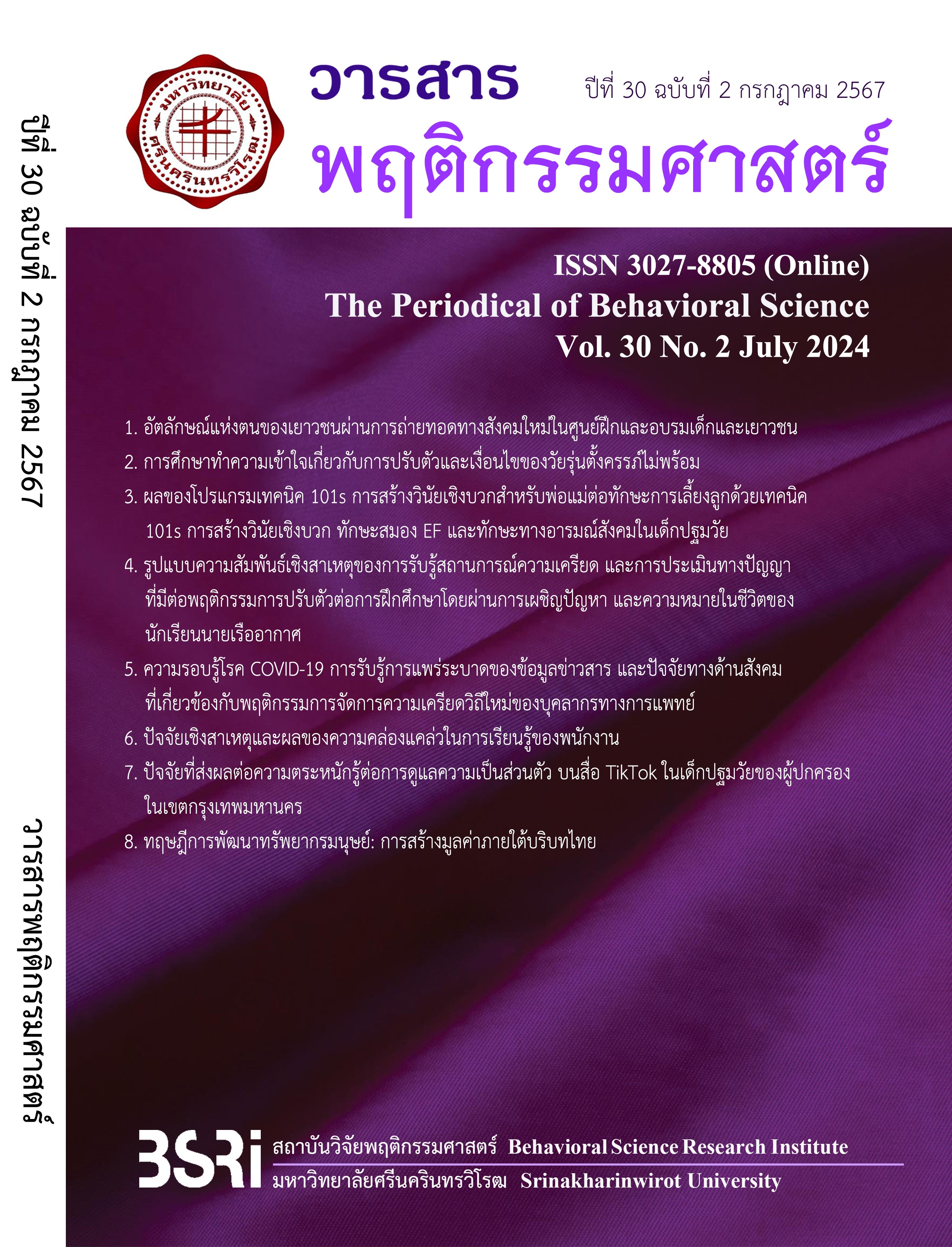Factors affecting awareness of privacy care on TikTok media among early childhood children of parents in Bangkok
Keywords:
Social Media, Early Childhood Parents, Early Childhood PrivacyAbstract
This research aims to study the level of opinions about factors that affect awareness of privacy on TikTok media in early childhood, and to study factors that affect awareness of privacy on TikTok in early childhood. The sample group used in the research was 423 parents of early childhood children between the ages of 0–6 years in Bangkok using a questionnaire. By using a questionnaire. Data were analyzed by frequency, percentage, mean, standard deviation and multiple regression analysis. The finding of the study are as follows: 1) the majority are female, aged 21-30 years old, employed in private company with monthly family income of 30,001 - 45,000 baht. 2) Various factors including psychological, situational, privacy and security as well as awareness and protection of personal information collectively contribute to the high level of awareness among parents and 3) Factors affecting awareness of privacy care on TikTok media in the same direction include psychological factor, situational factor and privacy and security factor. They can jointly predict awareness of privacy care on TikTok media in early childhood, with a total of 25.7 percent. Therefore, the equation for predicting the analysis of awareness of privacy care on TikTok media in early childhood is 1.800 + 0.107 (X2) + 0.099 (X3) + 0.332 (X4).
Downloads
References
Achaphet, N. (2021). Sharing children's information on social media: Children's rights that parents overlook. Journal of Business Administration and Liberal Arts Rajamangala Lanna, 9(2), 245-267.
Channoi, N. (2022). Sharenting behaviors of Thai parents [Master’s Thesis]. Chulalongkorn University.
Child Rights Protection Center. (2022). Post pictures of your child on social media. Without violating children's rights. https://www.thaichildrights.org/s tory/postphoto220122/
Chueasathapanasiri, T. (2022). Clear screen media, a threat affecting children's development and behavior in the digital age. https://op.mahidol.ac.th/ga/posttoday-45/
Department of Mental Health. (2019). WHO latest warning! Love your children the right way. Children under 5 years old: sit less - play more - away from screens. https://dmh.go.th/news-dmh/view.asp?id=29697
Garmendia, M., Martínez, G., & Garitaonandia, C. (2021). Sharenting, parental mediation and privacy among Spanish children. European Journal of Communication. https://doi.org/10.1177/02673231211012146
Jaimao, P. (2022). Factors affecting parents' behavior in promoting early childhood development, Li District, Lamphun Province [Master’s Thesis]. Naresuan University.
Legal and Development Research Center Chulalongkorn University. (2018). Thailand Data Protection Guidelines 2.0: Guidelines for personal data protection. Chulalongkorn University Printing House.
Likert, R. (1967). The Method of Constructing and Attitude Scale in Attitude Theory and Measurement. Wiley & Son.
Mahathalaeng, T. (2022). Protection of personal information of children and youth online. https://www.thailandplus.tv/archives/467406
Nukulsomprathana, P. (2024). Collection of important statistics and insights of Thai people on the use of Digital and social media 2024. https://www.popticles.com/insight/thailand-digital-and-social-media-stats-2024/
Nunnally, J. C. (1978). Psychometric Theory. McGraw-Hill.
Office of the Health Promotion Fund. (2020). Guidelines for raising children in the digital age. Internet Foundation joins in developing Thailand.
Office of the Personal Data Protection Commission. (2019). Summary of the main points of the Personal Data Protection Act 2019. https://www.dct.or.th/upload /downloads/1612025563SummaryPDPA_DigitalCouncilofThailand.pdf
Phetcharot, L., & Chamniprasat, A. (2019). Statistics for research and techniques for using SPSS (3rd ed.). Charoen Dee Mankong Printing Press.
Qustodio. (2023). Born connected: The rise of the AI generation. https://static.qustodio.com/public-site/uploads/2024/01/19122535/ADR_2023-24_EN.pdf
Ranzini, G., Newlands, G., & Lutz, C. (2020). Sharenting, Peer Influence, and Privacy Concerns: A Study on the Instagram-Sharing Behaviors of Parents in the United Kingdom. https://doi.org/10.1177/2056305120978376
Royal Academy. (2011). Royal Institute Dictionary 2011. Nanmee Books Publishing.
Royal Gazette. (2019). Family Institution Development and Protection Promotion Act 2019. Volume 136, Section 67.
Srisa-ard, B. (2013). Preliminary research. Suwareeyasan.
Unicef. (2563). A guide for parents and caregivers to keep children safe online during the COVID-19 pandemic. https://www.unicef.org/thailand/media/4131/file/94-19.pdf
Walrave, M., Robbé, S., Staes, L., & Hallam, L. (2023). Mindful sharenting: How millennial parents balance between sharing and protecting. Frontiers in Psychology, 14, 1171611. https://doi.org/10.3389/fpsyg.2023.1171611
We Are Social. (2023). Summary of Digital and Social Media statistics from We Are Social that every marketer needs to know, updated for 2023. https://thegrowthmaster.com/trends/digital-trend-statistic-2023
Yamane, T. (1973). Statistics: An introductory analysis. Harper. & Row.
Youn, S. (2005). Teenagers' perceptions of online privacy and coping behaviors: A risk– benefit appraisal approach. Journal of Broadcasting & Electronic Media, 49(1), 86-110.
Downloads
Published
How to Cite
Issue
Section
License
Copyright (c) 2024 The Periodical of Behavioral Science

This work is licensed under a Creative Commons Attribution-NonCommercial-NoDerivatives 4.0 International License.
Behavioral Science Research Institute, SWU
114 Sukhumvit 23, Bangkok 10110, Thailand.
Tel.02-649-5000 # 17600



